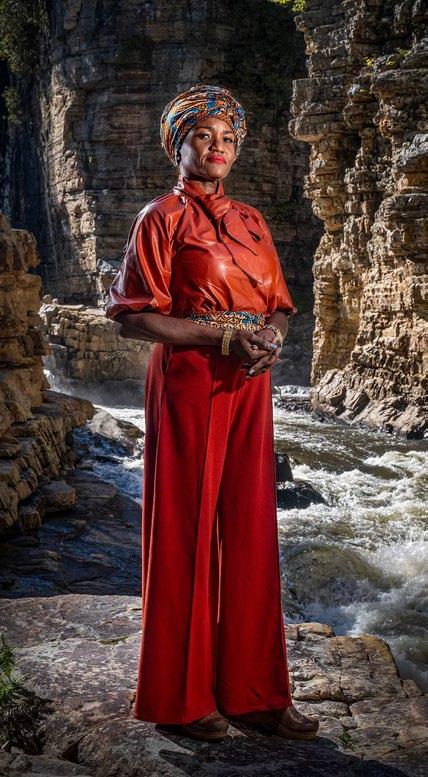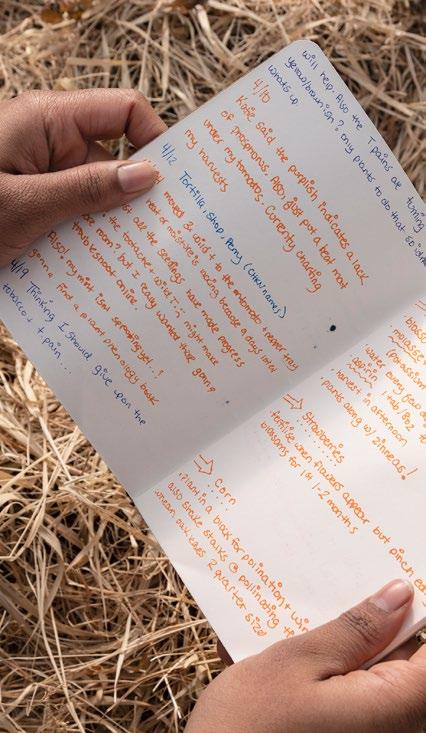
5 minute read
Climate Solutions
CLIMATE CHANGE IS ONE OF THE BIGGEST CHALLENGES HUMANITY HAS EVER FACED.
Our new Climate Solutions exhibit, opening this summer, asks: What can we do about it?
The exhibit puts a spotlight on Adirondackers who are making extraordinary contributions to shift the narrative on this story. They’re not passive bystanders—they’re active participants, addressing climate change in their homes and hometowns.
In the exhibit, which fills our Find Out Forest, you’ll encounter farmers who are relying on research to find more climate-friendly agricultural practices, storytellers who help us understand science through art, builders who ensure function is as elegant as form and environmental experts who are keeping a close eye on the ecosystems that surround us. You’ll also meet people who are ensuring underrepresented voices—those of Black, Indigenous and People of Color (BIPOC)—are included in these conversations.
The biggest step to take, though, won’t happen until you leave The Wild Center—and, we hope, find your own Climate Solution.
We’ll get you started. An interactive “Tinkering Studio” will let you get some hands-on experience with tools used by our experts. And throughout, we’ll give you fodder for ways you can quickly incorporate meaningful solutions into your own life, whether that’s by considering public transit, participating in local government, finding new uses for items you’d otherwise dispose of or paying more attention to the clothes you buy.
The exhibit covers four different missions:
CARING FOR OUR ONE HOME
We need to support the ecosystems that support life on Earth. By protecting clean air and water and promoting wildlife diversity, we leave the planet better than we found it. The best path forward involves input and wisdom from environmental scientists, Indigenous communities and other individuals often left out of the conversation.
REBUILDING OUR FOOD SYSTEM
It’s not enough to bring food production closer to the places we live. Building a more sustainable food system means finding ways to make our farming methods friendlier to the planet. But it also means providing access to healthy, culturally relevant food to everyone. That means bringing more people from more diverse backgrounds to the table when it comes to growing and distributing food.
TAKING ACTION ON CLIMATE CHANGE
Here, you’ll meet people who are putting their talents into action as they take steps to protect the planet. Hear from artists, educators, students and others who are using their passion to show how we can each play a role in this fight. And you’ll explore tools you can put to use yourself.
TRANSFORMING OUR ENERGY ECOSYSTEM
Get inside the walls of a structure that presents options you can consider while building or renovating the places we live and work. Learn how architects, builders and others are relying on ultra-efficient building materials, renewable energy and site design—so you can see how we can construct the house of tomorrow, today.
Climate Solutions will open in July. Learn more at wildcenter.org.



Marvels, indeed
To Dustin Angell, the men and women in these portraits are superheroes. His life-size photographs, featured throughout the exhibit, show scientists studying Adirondack ecosystems, farmers committed to sustainable food and students working toward change at the local level. In other words, they put a spotlight on people who have devoted their lives to climate solutions.
But these “gritty, secular saints,” as Angell called them, are just regular people, even while performing heroic acts. In observing his portraits, Angell hopes viewers will recognize their own capacity to act and make a difference.
“I think these portraits are a way to humanize science,” says Angell, an educator at the Archbold Biological Station in Florida. “Art is so wonderful, because it allows you to bring in the other dimensions of human experience— emotions, spirituality—and get people asking about the meaning of things. What’s the meaning of nature? What is our relationship as humans to nature? And those are the kinds of questions you start asking when you’re looking at art.”
Home grown
Birch Kinsey (pictured right) is on a mission to heal. As a farmer, she wants to repair the damage done to land after decades of harmful agricultural practices. As an activist, she wants to connect people long excluded from farming and land ownership to the soil. Her work touches on food sovereignty, sustainable agriculture and climate solutions—in short, climate justice.
Birch, who was a Youth Climate Intern at The Wild Center in 2019, says her role is to bridge a gap between yesterday and tomorrow. In nature, these transition areas are known as “ecotones.” “I see climate justice work as maintaining that ecotone,” she says. “Things are not getting past me. If I go somewhere, the soil will be better when I leave. If I go somewhere, there will be food for pollinators. If I go somewhere that looks dead, I will bring as much life as I can into it and make sure it can hold itself. I want to create those ecotones between human habitats and the rest of the world, because that’s the first thing we’re going to do in healing.”


Moss Def
It’s hard to envision just how much carbon the sixmillion-acre Adirondack Park is keeping out of the atmosphere. Perhaps this 11-foot-wide, 10-foot-tall wall covered in moss can get the point across? The soft, springy moss was harvested from ground about to be excavated from nearby private land. Then it was boiled in glycerine, to preserve it, and dyed different shades of green to indicate which parts of the park are trapping the most carbon. In all of these forested areas, the element stays locked inside trees and bogs, rather than becoming a greenhouse gas in the form of carbon dioxide. “The protections that have been put in the Adirondacks have helped create spaces where forests, bogs and other ecosystems can thrive,” says Stephanie Hanson, one of our exhibit developers. “Healthy ecosystems are key to helping manage rising temperatures by pulling down carbon from the atmosphere.”



Be part of the solution
The best climate solution is the one we reach together—and we can all learn from each other. Send us a photo of your own personal climate solution, and we may feature it in the exhibit for all to see. Whether you’ve built an at-home composter, installed energy-efficient light bulbs, changed your diet or cast a vote in a local election, we want you to tell us about it.

Scan the QR code and share your story and a photograph, if applicable, that shows how you’re finding your place in the climate movement.





